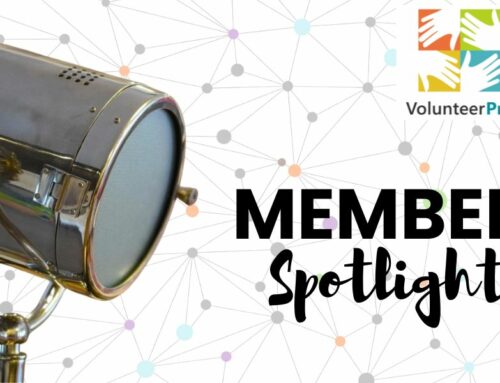As a Volunteer Manager, What Is Your Role in Nonprofit Crisis Communications?
It’s highly likely that your nonprofit crisis communications plan doesn’t consider aspects affecting the volunteer program, so it’s vitally important that you consider how you will communicate with your volunteers when something goes wrong.
Ahem, a global pandemic, social unrest, natural disasters, etc.!
Don’t leave your crisis communications to chance, and don’t make it overly complicated.
Read on for some tips to help you formulate your plan.
Tobi’s 5 C’s of Leadership in Nonprofit
Crisis Communications
Communicating effectively as a leader in today’s world is more important than ever. Taking a stand for your organization’s values and ensuring volunteers know how they fit in are essential.
Tobi has developed a simple framework for how to plan what, when, and how you will communicate with her five C’s for better nonprofit crisis communications.
Compassion
You cannot connect and communicate with your volunteers until you connect with them emotionally, you need to let them know you understand how they feel.
In times of stress, repeat back what you are hearing from your volunteers. If your volunteers are really worried about a natural disaster that is affecting your community, address it! If your organization isn’t a disaster response organization, talk to them about where they can go to seek added support for themselves, or volunteer to help people in the community.
Are you volunteers voicing concern over something that’s been happening internally? Perhaps a policy change that will affect how they work with your clients? Do not brush that complaining under the table! Be open with your volunteers about the issues that people have come to you with and use your pre-formulated responses to describe in more detail the decisions surrounding the change.
Listening and empathy are key tools for de-escalation. When under stress, people find it harder to listen, and they won’t be ready to hear what you have to say until they feel heard first. If you don’t lead with compassion your volunteers won’t let your guard down and they won’t feel as connected to your organization and their role as a volunteer.
Consistency
While you can’t predict every crisis, volunteers should know where, when, and how they will receive both regular and crisis communications from you as a volunteer leader. To that end, it’s important that even in normal times you are communicating on a regular basis. When you do this, you will start to build trust with your volunteers and confidence in the future, whatever comes next.
For example, with our VolunteerPro Premium Membership community, we send a weekly member update. Every Monday our members have an expectation that they will receive this communication from us.
That routine communication creates an expectation that no matter what is going on in the world, community, organization, etc., that communication is going to show up and there is going to be useful information in it!
While this communication is not generally crisis-oriented, it sets a firm foundation of expectations. If, in the future, we needed to implement a crisis recovery plan we could do so through that existing regular communications stream, with little disruption or confusion.
Clarity
Nonprofits are a world of jargon and acronyms, so this can be difficult to master. Nonprofit work and volunteer management is not basic, and it’s our duty to break communications down in a way that everyone can understand.
Want to know an easy way to accomplish this?
When you are creating your crisis communications response templates add three to five talking points that you can reiterate repeatedly, whether it’s in an email, in a newsletter, on social media, during a meeting, or anywhere else you are communicating with your volunteers.
With just three to five talking points for each possible scenario, you can keep your response simple; yet ensure your volunteers are getting the information they need.
Also, take care to reduce or explain the jargon you use when it comes to nonprofit crisis communication planning. You’ve likely developed some shorthand, but your volunteers don’t know this. Make it easy for them to follow instructions by making it crystal clear what they need to do and when.
Conviction
Leadership cannot be faked, so you must believe with you are saying and you must believe in yourself as a leader.
If you simply reiterating talking points you don’t believe in, volunteers will catch on and they will likely not listen to you, they will not collaborate with you, they will essentially resist you.
This is easy to do when you are the creator of a plan or are in full agreement with the course of action your agency plans to take.
But you must also learn how to lead with conviction, even when you might not agree with a decision.
For example, say your leadership team has decided that volunteers will be required to receive the COVID vaccine before returning to service, but you believe it should be optional for volunteers. You will need to come to terms with that decision before communicating it out to your volunteers otherwise, they are going to feel your resistance in rolling out the new policy.
If you are in disagreement with leadership, and you share that with volunteers, you set up an untenable situation. Volunteers are now forced to pledge their support for one of two points of view. The result will undoubtedly be inner conflict.
Unless a policy will cause real harm, iron out your differences with leadership after the danger has passed and by working your way up the chain of command. Though it may feel good in the moment, venting to volunteers is not helpful.
So, find a way to get on board because when you have conviction, the power of your work becomes true in the world!
Creativity
Leadership is also about inspiring people to be the better part of themselves, which can involve a lot of creativity!
Now, what do I mean by creativity? What I mean by creativity is that you can think about different ways you can reach your volunteers with your communications crisis plan.
You can meet in person, you can meet over Zoom, you can record a video, you can call, text or email. You can, and should, weave your communications in each of these areas.
Also, creativity helps bring out the emotional element for people, visuals, audio, a video, anything like that really helps bring up emotion and some volunteers will connect more with you as a leader.
Not every leader is the same, and yet many leaders find success. So, you do you!
Don’t be afraid to be creative with your leadership.
Finally, if you have compassion, consistency, clarity, conviction, creativity, that will also create in those who are following you, greater confidence and certainty. The more certain and confident they feel in you and in the program and what they’re doing together as a group, the more your leadership is going to be effective.
Leadership during a crisis is really important and, with the 5’s of leadership in your back pocket, you are now ready to take on your crisis management plans.
Note: for more on volunteer supervision and general communications strategies, check out Chapter 5 of our free Essential Guide to Managing Volunteers at Your Nonprofit on volunteer supervision here.
Learn the Difference Between Urgent and Crisis
In addition, it’s vital that you keep your cool when the inevitable stress hits. You must discern the level of action needed by quickly assessing whether what’s happening constitutes a true crisis or whether it is simply an urgent task.
To do this, follow this simple framework:
To be proactive, first write down some scenarios that might play out in your volunteer program (stay-at-home orders, virus outbreak, harassment, loss of a staff person or fellow volunteer, natural disaster, etc.) and code them in terms of their severity:
- Red – these situations demand an immediate response (harassment, death, weather closure of agency, etc.) via reaching out individually or mass communications.
- Orange – these situations aren’t as serious but still warrant a response and potentially a list of resources for volunteers and the community to reach out to for support. For example, if there is flooding in your region and you know people in the community need shelter, provide your volunteers with list of available shelters.
- Yellow – these situations don’t necessarily need a community response but might warrant an individual response. They might include situations of injuries “on the job”, illness of volunteers or staff, legal issues of volunteers or staff, etc. Before responding to anything in this category, ensure that you check your response with your HR and/or legal team.
Then, create a standard response template for each of the scenarios so that you are prepared in advance and can respond to a crisis or urgent community need promptly.
The big caveat: make sure you involve your organization’s legal, marketing, and public relations team to ensure that you are abiding by agency laws, regulations, and standards before sharing any of the responses you formulate!
When new crises come down the pike, simply repeat this process of rating and responding in kind.
Note: for more on nonprofit leadership strategies, check out our Top 10 Volunteer Leadership Development Posts for 2020 for a content roundup on our Tobi Johnson & Associates blog.
How to Prepare for a Crisis
It’s also important to actually do the actual preparation for future stressors that could disrupt operations.
While they might not seem like it on the surface, crisis communications are like other volunteer engagement techniques, it is, after all, another touchpoint with your volunteers. However, there are two exceptions: they appear and grow in scale quickly and if not addressed promptly they can affect the organization, community, individuals, etc.
So, it’s important to prepare for a crisis ahead of time.
Here are some types of crises you might want to respond to as a volunteer manager. Remember, no crisis is too small!
- Technical Issues – Is your volunteer management software down, meaning volunteers can’t check their schedule or sign up for new shifts?
- Natural Disasters – Is your organization closed due to a snowstorm or flooding or wildfires? How will your volunteers find this out? Are you prepared to supply a list of resources to your volunteers who might be feeling the effects of a natural disaster? For example, local shelter information for those who were displaced.
- Organization Issues – Is your organization merging with another? Is a program shutting down, thus displacing a group of volunteers? Plan for how you will communicate this with individual volunteers affected by the change and the volunteer community as a whole.
- Inappropriate Behavior – Bullying, harassment, and inappropriate behavior should not be tolerated at your organization; however, it’s important that you plan for minor, medium, severe infractions and have a policy written down of how they will be handled and how they will be communicated to the larger organization.
What to plan:
- Size and Scope of the Crisis – See above section on learning the difference between urgent and crisis.
- Internal Points of Contact – Does it make sense for your volunteers to reach out to you? Are there other staff they can reach out to for more information or to voice their concerns?
- Templates for Volunteer Crisis Communication – Your response should be two-fold. First, for emergent crises that immediately impact the organization, volunteers, or the community, create an acknowledgment statement of about 3-5 sentences. This can be deployed at a moment’s notice for emergency situations. Then, prepare a longer form communication template with more detailed information.
Your Nonprofit Crisis Communications
No matter how much planning you do, you won’t be able to prevent or even predict every crisis that comes through your door.
However, with the framework above you will be able to mitigate the fallout and provide clear and consistent communications that your volunteers will appreciate during stressful times of change.
Remember your 5 C’s – compassion, consistency, clarity, conviction, creativity. They are the keys to human-centered nonprofit crisis communications and are your best antidote to chaos and are your best bet for calm.







